

Traditional Swiss Folklore Music. Traditional Swiss Musical Instruments Switzerland. Switzerland Yodeling. Alps Horn Performance. Klezmer Music/Dance - Nahalat Shalom. Neither the Holocaust nor the migration out of Eastern Europe nor assimilation could stop it.

Klezmer music has undergone an enormous revival, which is also happily serving to help keep the Yiddish language alive. The revival has its origin, in part, in a renewed pride in their ethnicity that Jews began finding in the 70s, as a new generation of Jewish musicians forged connections across space and time with the musicians of 19th century Eastern Europe. The term klezmer comes from the Hebrew words "kley zemer", referring to the musical instruments themselves; gradually, the identities of the musician and his instrument merged to be covered by the one term. References to klezmer bands are found in surviving town records, memoirs, and historical accounts as early as the 15th century.
Paintings and woodcuts from those times show Jewish musicians playing instruments similar to those of their non-Jewish neighbors. KLEZMER MUSIC & YIDDISH SONGS by Mitteleuropa Ensemble - Ale Brider. What is Klezmer Music? - The Klezmer Fiddle. Indonesian Music - Part One. Search Detail. The music of Indonesia is as profoundly diverse and magnificent as its geography, religion, and culture.
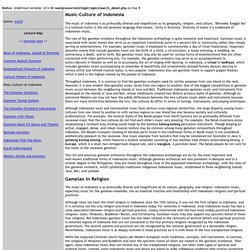
"Bhinneka Tunggal Ika" is a national motto in the old Javanese language that means, "Unity in Diversity. " Diversity of styles is a trademark of Indonesian music. The role of the gamelan orchestra throughout the Indonesian archipelago is quite extensive and important. Gamelan music is associated with social events that serve as an important transitional point in a person's life or community rather than simply serving as entertainment. For example, gamelan music is employed to commemorate a day of ritual importance. Throughout Indonesia, it is common to find the gamelan orchestra used for similar purposes from one island to the next. Although Indonesian vocal and instrumental music have obvious cross-regional similarities, the large disparity among music-cultures from one island to another or with various regions on one island has also become socially and culturally problematical.
Traditional musical instruments indonesia ~ AejicShare. Angklung is a musical instrument multitonal (double pitched) is traditionally grown in theSundanese-speaking community in the western part of Java Island.
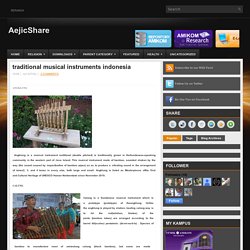
This musical instrument made of bamboo, sounded shaken by the way (the sound caused by impactbodies of bamboo pipes) so as to produce a vibrating sound in the arrangement of tones2, 3, and 4 tones in every size, both large and small. Angklung is listed as Masterpieces ofthe Oral and Cultural Heritage of UNESCO Human Nonbendawi since November 2010. Calung is a Sundanese musical instrument which is a prototype (prototype) of theangklung. Unlike the angklung is played by shaken, beating calung way is to hit the rod(wilahan, blades) of the joints (bamboo tubes) are arranged according to the barrel titi(scales) pentatonic (da-mi-na-ti-la) .
Gamelan is a musical ensemble that usually highlight metallophones, xylophone, drums, and gongs. Rebana (Java Language: Fly) is a round drum-shaped and flat. Japanese Culture - Entertainment - Musical Instruments. In traditional Japanese music, there are three general types of instruments - percussion instruments, stringed instruments and wind instruments, mostly flutes.
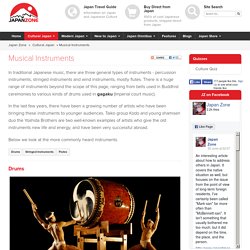
There is a huge range of instruments beyond the scope of this page, ranging from bells used in Buddhist ceremonies to various kinds of drums used in gagaku (Imperial court music). In the last few years, there have been a growing number of artists who have been bringing these instruments to younger audiences. Taiko group Kodo and young shamisen duo the Yoshida Brothers are two well-known examples of artists who give the old instruments new life and energy, and have been very successful abroad.
Below we look at the more commonly heard instruments. Drums. The traditional instruments of Japanese music. The shakuhachi is Japan's vertical bamboo flute with five finger holes, four in front and one at the back.
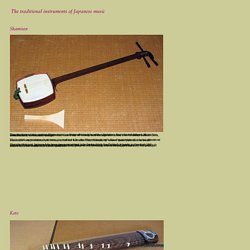
It is an ancient instrument and yet, due to its versatility, it has a uniquely contemporary appeal. Related to similar flutes found in China, India and the Middle East, The shakuhachi was first introduced into Japan around the end of the 7th century AD and evolved through a series of modifiations until it reached its present form during the 17th. century. Okami [Full Album] - Traditional Japanese Music. Celtic Music Instruments. From the thump of the Bodhrán to the airy rasp of the wooden flute, celtic music is known by its instruments.
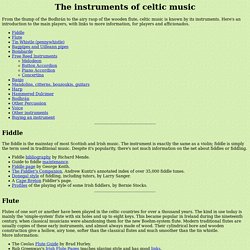
Here's an introduction to the main players, with links to more information, for players and afficionados. Fiddle. Celtic music. Celtic music is a broad grouping of musical genres that evolved out of the folk musical traditions of the Celtic people of Western Europe.[1][2] It refers to both orally-transmitted traditional music and recorded music and the styles vary considerably to include everything from "trad" (traditional) music to a wide range of hybrids.

Often the melodic line moves up and down the primary chords in so many songs. There are a number of possible reasons for this: Melodic variation can be easily introduced. These two latter usage patterns may simply be remnants of formerly widespread melodic practices. 2 Hours of Celtic Music. African music compilation - 38 minutes of african melodies. Exploring Africa. Module Thirteen: African Music Teacher's Edition A brief background and history of African Music The African continent is the second largest continent in the world, and its people constitute a 10th of the world’s population with about one thousand indigenous languages spoken throughout the continent (Stone, 1998, p.2).
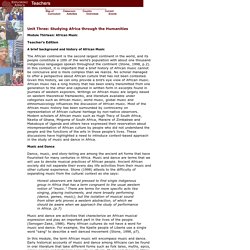
In this context, it is important that a brief history of African music cannot be conclusive and is more complex than we realize. No scholar managed to offer a perspective about African culture that has not been contested. Music and Dance Dance, music, and story-telling are among the ancient art forms that have flourished for many centuries in Africa. Honest observers are hard pressed to find single indigenous group in Africa that has a term congruent to the usual western notion of “music.” African Music -Part One. By Dumisani Maraire, Ph.
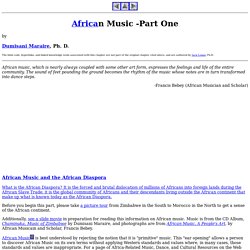
D. The html code, hyperlinks, and linked knowledge webs associated with this chapter are not part of the original chapter cited above, and are authored by Jack Logan, Ph.D.